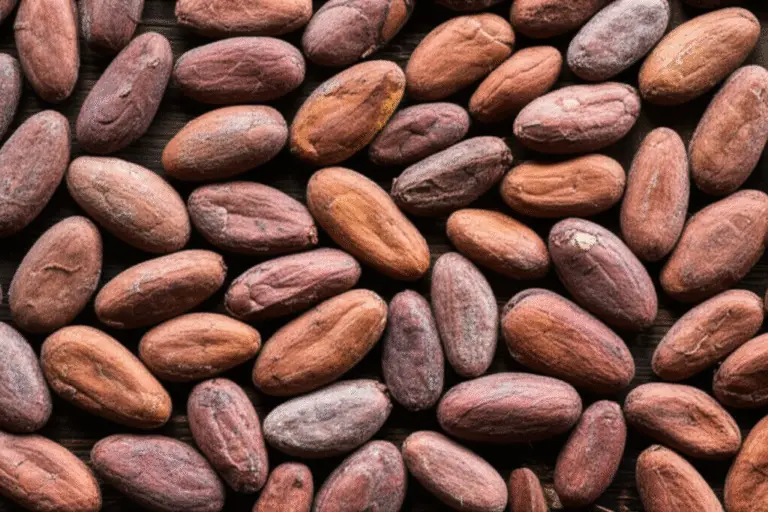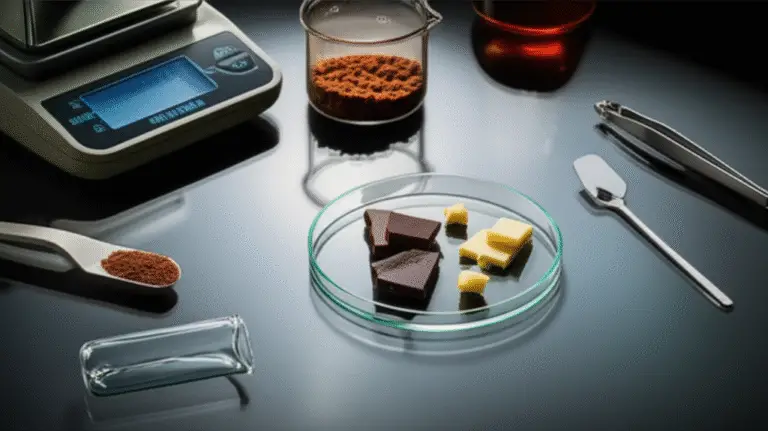Support our educational content for free when you purchase through links on our site. Learn more
How to Choose Safe Chocolate: 7 Expert Tips You Need 🍫 (2025)
Imagine biting into a luscious piece of chocolate, only to be hit by an unexpected allergen or worrying about hidden contaminants. At Chocolate Brands™, we’ve tasted and tested countless bars to help you navigate the complex world of chocolate safety. From decoding tricky labels to uncovering the truth about gluten, dairy, nuts, and even heavy metals, this guide reveals everything you need to pick chocolate that’s both delicious and safe.
Did you know that while pure chocolate is naturally gluten-free, many popular bars carry hidden risks due to cross-contamination or added ingredients? And that some dark chocolates can contain trace amounts of lead or cadmium? Stick around as we share our top 7 expert tips, plus trusted brand recommendations, so you can indulge confidently and guilt-free.
Key Takeaways
- Always read labels carefully and look for certifications like “Certified Gluten-Free” and “USDA Organic” to ensure allergen safety.
- Beware of cross-contamination risks in chocolate manufacturing, especially if you have severe allergies.
- Dark chocolate may contain higher levels of heavy metals like lead and cadmium; diversify your choices and opt for brands tested for safety.
- Choose ethical and sustainable brands with Fair Trade or Direct Trade certifications to support responsible sourcing.
- Trust brands with dedicated allergen-free facilities such as Enjoy Life Foods, Pascha Chocolate, and Taza Chocolate for safe indulgence.
- Proper storage preserves chocolate quality and safety—keep it cool, dry, and sealed away from odors.
- If you suspect a sensitivity, consult a healthcare professional and consider elimination diets to pinpoint triggers.
Ready to shop safe and tasty chocolate? Check out our curated selections from top allergen-friendly and ethical brands in the article below!
Table of Contents
- ⚡️ Quick Tips and Facts for Safe Chocolate Choices
- 🍫 The Sweet & Sometimes Sour History of Chocolate Safety: A Journey Through Time
- 🔍 Decoding “Safe Chocolate”: What Does It Really Mean for Your Health?
- 🚨 The Allergen Minefield: Navigating Gluten, Dairy, Nuts, and More in Your Chocolate Bar
- 1. Gluten-Free Chocolate: A Celiac’s Delight or a Hidden Trap?
- 2. Dairy-Free & Vegan Chocolate: Moo-ving Towards Plant-Based Indulgence
- 3. Nut-Free Chocolate: Cracking the Code for Allergy Sufferers
- 4. Soy-Free Chocolate: A Less Common, But Crucial Consideration
- Cross-Contamination: The Silent Threat in Chocolate Production
- 🧪 Heavy Metals in Chocolate: Should You Be Worried About Lead and Cadmium?
- 🌱 Ethical & Sustainable Chocolate: Sweetness Without the Bitterness of Exploitation
- 📜 The Label Lowdown: How to Become a Pro at Reading Chocolate Packaging
- 🏆 Our Top Picks: Brands We Trust for Safe & Delicious Chocolate
- 🏡 Storing Your Safe Chocolate: Keeping It Fresh and Flavorful
- 🤔 Think You May Have a Chocolate Sensitivity? What to Do Next
- Conclusion: Indulge Wisely, Indulge Safely!
- Recommended Links
- FAQ: Your Burning Chocolate Safety Questions Answered
- Reference Links
Hello, fellow chocolate lovers! Welcome to the Chocolate Brands™ tasting room. Pull up a chair, grab a square (or three, we don’t judge), and let’s talk about something that’s near and dear to our hearts: choosing chocolate that is not only delicious but safe. It sounds simple, right? But in a world of complex supply chains and hidden ingredients, picking the perfect, worry-free bar can feel like navigating a minefield.
But fear not! We’ve spent countless hours tasting, testing, and turning over packages to bring you the ultimate guide. We’re about to spill all the cocoa beans on how to choose chocolate that’s safe for you, your family, and the planet. Ready to become a chocolate safety sleuth? Let’s dive in!
⚡️ Quick Tips and Facts for Safe Chocolate Choices
Pressed for time? Here’s the condensed version of our expert advice:
- ✅ Read the Label, Always: The ingredients list and allergen warnings are your best friends. Look for certifications like “Certified Gluten-Free,” “USDA Organic,” and “Fair Trade.”
- ❌ Don’t Assume “Dark” Means Safe: While delicious and full of flavanols, dark chocolate can be a surprising source of allergens and even heavy metals.
- ✅ Know Your Allergens: Pure chocolate is naturally gluten-free and dairy-free, but additives and cross-contamination are rampant. If you have a severe allergy, look for brands made in dedicated allergen-free facilities.
- ✅ Go for Simple Ingredients: The best chocolate bars often have the shortest ingredient lists: cocoa, sugar, maybe some cocoa butter and vanilla. Fewer ingredients mean fewer chances for unwanted surprises.
- ❌ Beware of Cross-Contamination: A chocolate bar might not contain nuts as an ingredient, but if it’s made on the same equipment as a nutty one, it’s a risk. “May contain” warnings are there for a reason!
- ✅ Choose Ethical Brands: Look for Fair Trade or Direct Trade certifications to ensure your treat isn’t contributing to unfair labor practices.
🍫 The Sweet & Sometimes Sour History of Chocolate Safety: A Journey Through Time
Believe it or not, concerns about what’s in our chocolate are nothing new. The journey of chocolate from a sacred Aztec beverage to the global phenomenon it is today is a fascinating one, with a few safety bumps along the way. You can explore more about its rich past in our Chocolate History and Origins section.
Early chocolate was a gritty, bitter affair, often mixed with spices and corn. As Europeans adapted it to their sweeter palates, the race to mass-produce it began. In the 19th century, this sometimes led to… let’s call them “creative” additions. Some manufacturers, looking to cut costs, would add fillers like brick dust, tallow, and starch to their cocoa powder! It took pioneers of purity and government regulations to clean up the industry and ensure that when you bought chocolate, you were actually getting chocolate.
Today, the concerns are different but just as important. We’re no longer worried about brick dust (thank goodness!), but we are vigilant about modern contaminants: undeclared allergens, pesticide residues, heavy metals from the soil, and the ethical implications of its production.
🔍 Decoding “Safe Chocolate”: What Does It Really Mean for Your Health?
So, what do we mean by “safe chocolate”? It’s a loaded term! For us, it’s a delicious trifecta of concerns:
- Allergen Safety: Is it free from ingredients that could cause a reaction, from mild intolerance to severe anaphylaxis?
- Contaminant Safety: Does it have minimal levels of unwanted substances like heavy metals or pesticides?
- Ethical Safety: Was it produced without exploiting people or the planet?
Understanding Common Concerns: Beyond Just Calories
Let’s be honest, the first thing most people check is the calorie count. But true chocolate safety goes much deeper. It’s about ensuring that your moment of indulgence doesn’t come with a side of worry. Whether you’re a parent packing a treat for a child with a nut allergy, someone with celiac disease, or simply a conscious consumer who wants the best, understanding these layers of safety is key. We’ll break down each of these areas so you can feel confident in your choices.
🚨 The Allergen Minefield: Navigating Gluten, Dairy, Nuts, and More in Your Chocolate Bar
This is where things get tricky. Pure, unadulterated chocolate is naturally free from most major allergens. But when was the last time you saw a bar with just one ingredient? Add-ins, flavorings, and shared factory equipment create a complex web for anyone with food sensitivities.
1. Gluten-Free Chocolate: A Celiac’s Delight or a Hidden Trap?
Here’s the good news: pure chocolate does not contain gluten. As the experts at Santa Barbara Chocolate point out, gluten can be introduced through added ingredients like cookie pieces, malt, or certain flavorings.
The real villain, however, is often cross-contamination. Beyond Celiac, a leading celiac disease organization, warns, “For brands that have many products with add-ins and fillings (which are likely to have gluten-containing ingredients), the chocolate is often at risk for cross contamination.” This is why a simple ingredient list isn’t always enough.
What to look for:
- ✅ “Certified Gluten-Free” Seal: This is your gold standard. It means the product has been tested and meets strict gluten-free guidelines.
- ✅ Dedicated Facilities: Brands that produce their chocolate in a gluten-free facility offer the highest level of assurance.
- ❌ “May Contain Wheat” Warning: If you see this, and you have celiac disease or a severe sensitivity, it’s best to steer clear.
2. Dairy-Free & Vegan Chocolate: Moo-ving Towards Plant-Based Indulgence
Dark chocolate is often dairy-free, but not always. Milk fat is sometimes added for a smoother texture. Milk and white chocolates, by definition, contain dairy. The good news? The market for delicious vegan chocolate is exploding! Brands are using creative alternatives like rice milk, oat milk, and coconut milk to create creamy, satisfying treats without the dairy.
Watch out for:
- Hidden Dairy: Ingredients like “casein,” “whey,” and even some “natural flavors” can be derived from milk.
- Cross-Contamination: Just like with gluten, shared equipment is a major concern. Look for brands that explicitly state they are made in a dairy-free facility.
3. Nut-Free Chocolate: Cracking the Code for Allergy Sufferers
This is a big one. Nuts and chocolate are a classic pairing, which makes finding truly nut-free chocolate a challenge. For someone with a severe nut allergy, even microscopic traces can be dangerous.
Our tasting team has a member with a severe peanut allergy, and we take this very seriously. The only way to be truly safe is to choose brands that operate out of dedicated nut-free facilities.
Brands we trust for nut safety:
- Enjoy Life Foods: A pioneer in the allergy-friendly space, all their products are free from 14 common allergens, including peanuts and tree nuts.
- No Whey! Foods: Their entire line is free from the top 9 common allergens and produced in a dedicated facility.
- Pascha Chocolate: They produce their chocolate in a facility free from all eight major food allergens, including peanuts and tree nuts.
4. Soy-Free Chocolate: A Less Common, But Crucial Consideration
Soy, in the form of soy lecithin, is a very common ingredient in chocolate. It’s an emulsifier, which means it helps keep the cocoa butter and cocoa solids blended, creating a smooth, uniform texture. While the amount is small, it’s a no-go for those with a soy allergy. Thankfully, many premium and allergy-friendly brands are now opting for alternatives like sunflower lecithin or forgoing emulsifiers altogether.
Cross-Contamination: The Silent Threat in Chocolate Production
We’ve mentioned it in every section, but it deserves its own spotlight. Cross-contamination is the invisible risk that occurs when a “safe” product is exposed to an allergen in the manufacturing environment.
As Beyond Celiac wisely advises, “Calling the manufacturer is a must.” If you have a life-threatening allergy, don’t just rely on the label. Contact the company and ask about their manufacturing processes. Do they use shared lines? What are their cleaning procedures? A reputable company will be transparent and happy to answer your questions.
🧪 Heavy Metals in Chocolate: Should You Be Worried About Lead and Cadmium?
Okay, let’s address the scary headlines. Recent reports from organizations like Consumer Reports have found concerning levels of lead and cadmium in some popular dark chocolate bars. It’s alarming, but let’s break it down.
How do they get there?
- Cadmium is taken up from the soil by the cacao plant. It’s a naturally occurring element, and levels can vary depending on the geology of the growing region.
- Lead seems to get into the cacao beans after they are harvested. It can come from dust and soil that settles on the beans as they dry outdoors.
Dark chocolate tends to have higher levels because it contains more cocoa solids, which is where the metals accumulate.
Which Chocolates Are Most Affected? Dark vs. Milk vs. White
| Chocolate Type | Cocoa Solids Content | Risk of Heavy Metals |
|---|---|---|
| Dark Chocolate | High (50-100%) | Highest |
| Milk Chocolate | Lower (10-50%) | Lower |
| White Chocolate | None (Cocoa Butter Only) | Lowest |
Our Expert Tips for Minimizing Exposure
This doesn’t mean you have to give up your beloved dark chocolate! Here’s how to indulge more safely:
- Don’t Panic, Diversify: Don’t eat the same bar of dark chocolate every single day. Vary the brands you buy and the regions the cacao comes from.
- Check the Reports: Consumer Reports and other watchdog groups have published lists of brands with lower levels. Brands like Mast, Taza Chocolate, and Ghirardelli (specifically their Intense Dark bars) have fared well in some tests.
- Consider the Source: Some studies suggest that cacao from Latin America may have higher cadmium levels due to soil composition, while African cacao may have lower levels.
- Watch the Video: The embedded video, “How to Find the Best Dark Chocolates and Cocoas and Avoid Cadmium Contamination” by ConsumerLab.com, offers some excellent visual guidance and deeper insights on this very topic.
For a more in-depth look, check out our dedicated article on chocolate without heavy metals.
🌱 Ethical & Sustainable Chocolate: Sweetness Without the Bitterness of Exploitation
A truly “safe” chocolate is one that’s safe for everyone involved, including the farmers who grow the cacao. The cocoa industry has long been plagued by issues of poverty, child labor, and deforestation. But you have the power to support a better way!
Fair Trade & Beyond: Certifications That Matter
When you see these logos on a package, it’s a signal that the brand is committed to higher standards.
- Fair Trade: This is one of the most recognized certifications. It ensures farmers receive a minimum price for their cocoa, plus an additional premium to invest in their communities.
- Rainforest Alliance: The little frog logo indicates that the cacao was grown on farms that meet standards for environmental, social, and economic sustainability.
- Direct Trade: Some companies, like Taza Chocolate, bypass the middlemen and work directly with cacao farmers. This often means they pay an even higher premium than Fair Trade standards and build long-term, personal relationships with their growers.
The Rise of Bean-to-Bar: Transparency from Farm to Your Mouth
The “bean-to-bar” movement is all about transparency. These makers control every step of the process, from sourcing the raw cacao beans to crafting the final bar. This gives them unparalleled control over quality, safety, and ethics. Brands like Tony’s Chocolonely have built their entire mission around creating 100% slave-free chocolate and being transparent about their supply chain through their “5 Sourcing Principles.”
📜 The Label Lowdown: How to Become a Pro at Reading Chocolate Packaging
The chocolate wrapper is your treasure map to finding a safe and delicious bar. Here’s what our tasters always look for.
Key Ingredients to Look For (and Avoid!)
According to FDA regulations, ingredients must be listed in descending order by weight.
-
✅ Look For:
- Cocoa (or Cacao, Cocoa Mass, Chocolate Liquor): This should be the first ingredient in any good dark chocolate.
- Cocoa Butter: This is the natural fat from the cocoa bean. It gives chocolate its melt-in-your-mouth quality.
- Sugar: A necessary component for sweetness.
- Vanilla: Real vanilla, not artificial vanillin, is a sign of quality.
-
❌ Watch Out For:
- Excess Sugar: If sugar is the first ingredient, it’s more of a candy bar than a chocolate bar.
- Vegetable Oils (like Palm Oil): These are often used as a cheaper substitute for cocoa butter and can indicate a lower-quality product.
- Artificial Flavors & Emulsifiers (besides sunflower lecithin): High-quality chocolate doesn’t need them.
Understanding Certifications and Seals
We’ve mentioned them before, but they’re worth repeating. Scan the package for these symbols of safety and quality:
- USDA Organic: Guarantees the cacao was grown without synthetic pesticides or fertilizers.
- Non-GMO Project Verified: Ensures the ingredients are free from genetically modified organisms.
- Certified Gluten-Free: The gold standard for celiac safety.
- Fair Trade / Direct Trade: Your sign of an ethically sourced bar.
- Vegan: Certifies the product is free from all animal products.
🏆 Our Top Picks: Brands We Trust for Safe & Delicious Chocolate
After countless tasting sessions, here are some of the brands that consistently earn our team’s seal of approval for safety, ethics, and, of course, taste! You can find more in-depth analyses in our Chocolate Brand Comparisons and Chocolate Bar Reviews.
| Brand | Allergen Safety | Heavy Metal Consciousness | Ethical Sourcing | Overall Taste |
|---|---|---|---|---|
| Enjoy Life Foods | 10/10 | 7/10 | 7/10 | 8/10 |
| Pascha Chocolate | 10/10 | 8/10 | 9/10 | 8/10 |
| Taza Chocolate | 8/10 | 9/10 | 10/10 | 9/10 |
| Alter Eco | 7/10 | 8/10 | 10/10 | 9/10 |
| Tony’s Chocolonely | 6/10 | 7/10 | 10/10 | 9/10 |
For Allergen-Sensitive Indulgence
When you absolutely cannot risk exposure to an allergen, these brands are our top recommendations. They are known for their dedicated allergen-free facilities.
- Enjoy Life Foods: The go-to for many with severe allergies. Their entire product line is free from gluten and 14 common allergens.
- Pascha Chocolate: Pure, simple, and delicious. They are made in a facility free from the top 8 allergens and are also organic and vegan.
- No Whey! Foods: A fantastic choice for fun, kid-friendly chocolates that are safe for almost everyone. They are free from the top 9 allergens.
👉 Shop Allergen-Free Chocolate on:
- Enjoy Life Foods: Amazon | Walmart | Official Website
- Pascha Chocolate: Amazon | Walmart | Official Website
- No Whey! Foods: Amazon | Walmart | Official Website
For Heavy Metal Conscious Consumers
Based on independent testing, these brands have been noted for having lower levels of lead and cadmium in their dark chocolate products.
- Taza Chocolate: This brand has appeared on “safer choices” lists and is also committed to ethical direct trade sourcing.
- Ghirardelli: Specifically, their Intense Dark 86% Cacao and Intense Dark Twilight Delight 72% Cacao bars have tested well.
- Mast: Their Organic Dark Chocolate 80% Cacao bar also scored very well in Consumer Reports’ testing for low levels of both metals.
👉 Shop Lower Heavy Metal Chocolate on:
- Taza Chocolate: Amazon | Walmart | Official Website
- Ghirardelli: Amazon | Walmart | Official Website
- Mast: Amazon | Official Website
For Ethical & Sustainable Choices
These brands put people and the planet at the forefront of their mission.
- Tony’s Chocolonely: Their mission to make all chocolate 100% slave-free is bold and inspiring. Their 5 Sourcing Principles are a model for the industry.
- Alter Eco: A certified B Corp, they are committed to regenerative agriculture and use eco-conscious, compostable packaging.
- Taza Chocolate: Their pioneering Direct Trade program ensures transparency and that farmers are paid significantly above Fair Trade prices.
👉 Shop Ethical Chocolate on:
- Tony’s Chocolonely: Amazon | Walmart | Official Website
- Alter Eco: Amazon | Walmart | Official Website
🏡 Storing Your Safe Chocolate: Keeping It Fresh and Flavorful
You’ve found the perfect, safe chocolate bar. Hooray! Now, how do you keep it that way? Storing chocolate properly is crucial to preserving its flavor and texture.
- Keep it Cool & Dry: The ideal temperature for chocolate is between 65-68°F (18-20°C) with humidity below 55%. A cool pantry or cupboard away from the stove is perfect.
- Avoid the Fridge (If You Can): The refrigerator is actually too humid for chocolate. This moisture can cause “sugar bloom,” a harmless but unappetizing white, grainy coating. The fridge is also full of odors, and chocolate is like a sponge—it will absorb the aroma of last night’s leftovers!
- Seal It Tight: Oxygen and light are enemies of flavor. Once opened, wrap your chocolate tightly and store it in an airtight container to protect it.
- If You Must Refrigerate: In a hot climate, sometimes the fridge is your only option. To do it right, wrap the chocolate tightly, seal it in an airtight container, and when you take it out, let it come back to room temperature before unwrapping. This prevents condensation from forming on the bar.
🤔 Think You May Have a Chocolate Sensitivity? What to Do Next
Do you ever feel… off after eating chocolate? While a true chocolate allergy is rare, sensitivities to other components are more common. It could be a reaction to:
- Dairy, soy, or nuts hidden in the bar.
- Caffeine and theobromine, natural stimulants in cocoa that can cause jitters or headaches in some people.
- Other compounds in chocolate that can trigger migraines in susceptible individuals.
If you suspect an issue, the best course of action is to consult with a doctor or a registered allergist. They can help you pinpoint the cause. You might try an elimination diet, temporarily removing chocolate and then reintroducing a pure, simple, allergen-free dark chocolate bar to see how you react. This can help determine if the issue is the cocoa itself or one of the many other ingredients commonly found in chocolate products.
Conclusion: Indulge Wisely, Indulge Safely!
Choosing safe chocolate might seem like a daunting quest at first, but armed with knowledge and a discerning eye, it quickly becomes a joyful adventure. From understanding allergens and decoding labels to considering ethical sourcing and heavy metal concerns, you now have the tools to select chocolate that not only delights your palate but also protects your health and conscience.
Remember, pure chocolate itself is naturally gluten-free and dairy-free, but the devil is in the details—additives, cross-contamination, and manufacturing practices can introduce risks. Our expert team at Chocolate Brands™ recommends sticking to trusted brands with transparent sourcing, clear allergen policies, and certifications that align with your needs.
Whether you’re avoiding gluten, dairy, nuts, or soy, or simply want to minimize exposure to heavy metals, there’s a safe chocolate out there for you. Brands like Enjoy Life Foods, Pascha Chocolate, and Taza Chocolate have proven themselves as reliable choices for allergen-sensitive and ethically minded consumers.
And if you ever feel unsure, don’t hesitate to reach out to manufacturers directly. As we said earlier, calling the manufacturer is a must for those with severe allergies or sensitivities.
So go ahead—indulge wisely, indulge safely, and savor every bite of your chocolate experience without a shred of doubt. After all, chocolate should be a source of joy, not worry!
Recommended Links
Ready to shop some of our top safe chocolate picks? Here are quick links to get you started:
- Enjoy Life Foods: Amazon | Walmart | Official Website
- Pascha Chocolate: Amazon | Walmart | Official Website
- Taza Chocolate: Amazon | Walmart | Official Website
- Tony’s Chocolonely: Amazon | Walmart | Official Website
- Alter Eco: Amazon | Walmart | Official Website
For a deep dive into chocolate safety and health, consider these insightful books:
- The True History of Chocolate by Sophie D. Coe & Michael D. Coe — A fascinating exploration of chocolate’s origins and evolution.
- Chocolate Wars: The 150-Year Rivalry Between the World’s Greatest Chocolate Makers by Deborah Cadbury — A gripping account of the chocolate industry’s challenges and triumphs.
- The Chocolate Connoisseur by Chloé Doutre-Roussel — A guide to tasting and appreciating fine chocolate.
FAQ: Your Burning Chocolate Safety Questions Answered
What ingredients should I look for in safe chocolate?
Look for simple, recognizable ingredients: cocoa or cacao, cocoa butter, sugar, and natural vanilla. Avoid bars where sugar is the first ingredient or that contain vegetable oils like palm oil, artificial flavors, or excessive emulsifiers. For allergen safety, check for the absence of dairy, nuts, soy, and gluten-containing ingredients. Certified labels such as “Certified Gluten-Free” or “Vegan” can help guide your choice.
How can I tell if chocolate is free from harmful additives?
Check the ingredient list carefully. Harmful additives often include artificial colors, flavors, preservatives, and hydrogenated fats. High-quality chocolates typically avoid these. Also, look for USDA Organic certification, which restricts synthetic additives. If you want to be extra cautious, choose bean-to-bar brands that emphasize transparency and minimal processing.
Are organic chocolates safer to eat?
Organic chocolates are generally safer in terms of pesticide residues and synthetic chemical exposure because organic farming prohibits most synthetic pesticides and fertilizers. However, organic certification does not guarantee allergen safety or absence of heavy metals. It’s one piece of the puzzle, but not the whole picture.
What certifications indicate safe and ethical chocolate production?
Look for:
- Certified Gluten-Free: Ensures the product meets strict gluten-free standards.
- USDA Organic: Indicates organic farming practices.
- Fair Trade: Guarantees fair wages and ethical treatment of farmers.
- Rainforest Alliance: Focuses on environmental and social sustainability.
- Direct Trade: Indicates direct sourcing relationships with farmers, often with higher premiums paid.
- Vegan: Confirms no animal products are used.
These certifications help you identify chocolate that is safer for your health and kinder to the planet.
How do I avoid chocolates with high sugar and unhealthy fats?
Read the nutrition label and ingredients. Choose bars where sugar is not the first ingredient and avoid those listing hydrogenated or partially hydrogenated oils. Look for chocolates with higher cocoa content (70% or above) as they tend to have less sugar. Also, avoid white chocolates or milk chocolates with added fillers or vegetable oils.
Is dark chocolate healthier and safer than milk chocolate?
Dark chocolate generally contains more cocoa solids and less sugar than milk chocolate, making it richer in antioxidants and flavanols. However, it can also have higher levels of heavy metals like lead and cadmium. Milk chocolate usually contains dairy and more sugar but tends to have lower heavy metal content. Neither is inherently “safer” — it depends on your personal health needs and sensitivities.
Can chocolate cause allergies or sensitivities?
Yes. While true chocolate allergies are rare, many people react to common allergens found in chocolate products, such as dairy, nuts, soy, or gluten from cross-contamination. Additionally, some individuals are sensitive to caffeine and theobromine in chocolate, which can cause headaches or jitters. Always check labels and consult a healthcare professional if you suspect a sensitivity.
How do I minimize the risk of cross-contamination when buying chocolate?
Choose brands that produce their chocolate in dedicated allergen-free facilities or those with strict cross-contact controls. Look for clear allergen statements on packaging. When in doubt, contact the manufacturer directly to inquire about their production practices.
What is the best way to store chocolate to maintain its safety and quality?
Store chocolate in a cool, dry place away from direct sunlight and strong odors. Avoid refrigeration unless necessary, and if you do refrigerate, seal the chocolate tightly and allow it to come to room temperature before unwrapping to prevent condensation. Proper storage preserves flavor and prevents sugar or fat bloom.
Reference Links
- Beyond Celiac: Choosing Safe Foods – Seafood, Chocolate, and Cheese
- Santa Barbara Chocolate: Does Chocolate Have Gluten? Exploring Different Types of Chocolate
- Consumer Reports: Lead and Cadmium in Dark Chocolate
- Enjoy Life Foods Official Website
- Pascha Chocolate Official Website
- Taza Chocolate Official Website
- Tony’s Chocolonely Official Website
- Alter Eco Official Website
- FDA Gluten-Free Labeling Guidance
- Celiac Disease Foundation: Reading Food Labels
Thanks for joining us on this deep dive into how to choose safe chocolate! Now go forth, savor wisely, and share the joy of chocolate that’s as safe as it is scrumptious. 🍫✨






